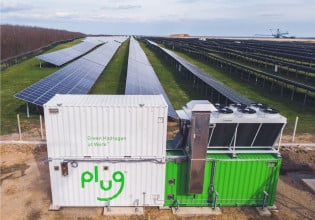HVDC Transmission Expansions in Japan, US
A pair of high-voltage direct current transmission projects are coming to Japan and the U.S., while the DOE funds other HVDC innovations.
Japan and the United States are upgrading their high-voltage direct current (HVDC) transmission infrastructure to support the renewable energy transition. Meanwhile, the U.S. Department of Energy (DOE) recently unveiled $10 million in funding for research projects tackling HVDC transmission costs.
One of Ameren Illinois’ steel monopoles. Image used courtesy of Ameren Illinois
HVDC transmission is useful for integrating bulk power renewable energy sources to transport electricity over long distances with minimal power losses. This is a crucial demand in the energy transition as renewables—particularly offshore wind farms—could be located far from load centers and require advanced transmission systems for reliability.
Japan Upgrades Transmission Lines With VSC Technology
J-Power Transmission Network Co., an electric company that operates 1,491 miles of transmission lines and nine substations/converter stations in Japan, awarded Mitsubishi Electric Corporation a deal to supply a 300-megawatt (MW) HVDC voltage source converter (VSC) for its frequency converter station in Hamamatsu, a coastal city located about 155 miles southwest of Tokyo.
Mitsubishi Electric’s VSC includes next-generation modular multi-level converters (MMCs) with status synchronous compensator (STATCOM) technology. VSCs are designed to link HVDC and high-voltage alternating current (HVAC) transmission lines via power electronics devices.
Mitsubishi Electric’s VSCs use highly efficient, high-performance 6.5-kilovolt (kV) / 1.0 kiloamp (kA) insulated gate bipolar transistors, enabling more compact converter stations. MMCs are flexible in that they scale power output from 50 MW to 1 gigawatt (GW) and beyond. The VSC system provides ancillary benefits like reactive power control, black start functions, and fast power-flow reversal via its fixed DC voltage polarity.
HVDC-Diamond features modular multi-level converter topology. Image used courtesy of Mitsubishi Electric
The system, slated to enter service by March 2028, comes as Japan undergoes a nationwide overhaul to develop high-capacity DC transmission facilities and boost the overall stability of its power supplies. Japan’s electricity supply operates at two frequencies, with 50 Hz on the eastern side and 60 Hz on the west. Grids can’t be directly connected when operating at different frequencies, making converters necessary to send and receive power between both regions.
The project aims to boost interconnectivity between stations by building a new 50/60 Hz frequency conversion facility on the border straddling the two regions.
Illinois Adds New Transmission Lines
Meanwhile, in the United States, Ameren Illinois received approval for a transmission line to improve grid reliability in LaSalle County, with 138 kV paths for transmission. The system will provide additional flexibility to minimize the frequency and duration of local power outages. If a failure appears on one line, Ameren Illinois will switch to another line to avoid service disruptions.
Ameren Illinois, which serves more than 1 million electric customers statewide, will run the line from its substation in Oglesby to another substation near North Utica, situated about 11 miles apart. The company held public meetings to chart the line’s ideal route.
The project is part of Ameren Illinois’ LaSalle Link Project, which aims to improve grid reliability, create additional pathways anticipating future energy demands, reduce power outages, and upgrade outdated substations. The total investment, including substation and line upgrades, is estimated at around $33 million.
Ameren Illinois’ LaSalle Link Project will use a steel monopole structure. Image used courtesy of Ameren Illinois
The new structures will be galvanized steel monopoles on concrete drilled shaft foundations. The structures, which range in height from 80 to 120 feet, are efficient and durable, take up a small land footprint, and allow larger spans between poles, thanks to the concrete foundations.
Construction is expected to begin next spring and finish in mid-2025.
DOE Funding for HVDC VSC Innovations
DOE is fueling $10 million into research projects aiming to cut costs for HVDC VSC transmission systems, which enable long-distance power delivery for the nation’s growing pipeline of offshore and onshore wind projects. HVDC transmission, which involves switching from AC to DC power and vice versa, can use VSCs to independently control the power flow and turn on/off as needed, which equates to more stable grid functions.
The program aligns with the DOE’s 2035 target to cut HVDC system costs by 35% and expand adoption to support grid interconnection for renewable projects. In a presentation earlier this year, DOE cited several barriers to HVDC system adoption, such as the lack of modeling capabilities and interoperability of systems with different vendors and control scalability.
In its funding opportunity, DOE outlined potential target areas for VSC designs in high demand. For example, increased power capacity on the nation’s grid can provide higher efficiency to allow more generation connections to a single substation. Other needs include increasing the voltage limit of VSCs to extend the distance between HVDC transmission lines, improving the lifespan of HVDC converters beyond the typical 25 years, and extending the life of power electronic components.
Factors that influence HVDC system costs. Image used courtesy of DOE
For offshore wind, in particular, size and power density are critical. Offshore substations are hulking units, racking up high installation and construction costs as they typically weigh over 1,000 tons. For example, New York’s upcoming 130-MW South Fork Wind project features a 1,500-ton substation. Overall system costs would be lowered with smaller substations or by increasing the power density of converter substations.










